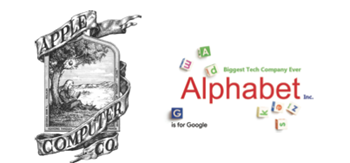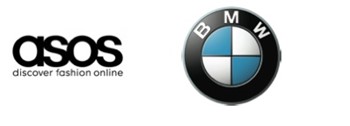How to repot a brand

Sometimes, like a plant that outgrows its pot, a brand must adapt to accommodate changes to its products or sector. How do organisations faced with this challenge approach rebranding, renaming and repositioning. Emily Andrews investigates
There are a variety of reasons why a company might undergo a rebrand, from cultural change externally to a need to differentiate itself in a competitive market. One of the factors that drives organisations to change their names or visual identities, is a shift in the products or services offered. In a rapidly changing environment, businesses must constantly evolve their offering to meet demand. Over a long time period, the products and services provided by a company can change drastically, and the brand may get left behind.
One of the world’s most respected brands, Apple, started life as Apple Computer, but in early 2007, was renamed Apple Inc. The change was, at the time, controversial, but – with the clarity of hindsight – it is a testament to Steve Job’s forethought. Apple Computers would be a deeply unsatisfactory name for Apple and all that it now does as a business. Computers are just a small portion of what the company now offers its customers.
The tech sector, due to the rapid nature of its ongoing change, is particularly inclined to this type of rebrand motivation. In the past year Google launched parent brand, Alphabet, and Logitech dropped the ‘tech’ from its name. Google had become synonymous with the market-leading search engine, when that is only part of what Google was doing as a business. The Alphabet Inc conglomerate encompasses tech companies Calico, Fiber, Nest and the Google X research and development lab, as well as Google. Although Google began life as a search engine in 1995, the breadth of its offering had changed and expanded so dramatically that it became necessary to create a new parent brand.
The case with Logitech is quite different. The company felt that the ‘tech’ in its name would limit its future development as it expands into new territories such as mobility and the connected home. The new Logi label, and the bright, new design, which is geared towards a more youthful audience, only appears on new and future product ranges, while Logitech’s more traditional products – such as keyboards and mice – continue to display the old Logitech brand.
This demonstrates how heavily its brand is intertwined with its product offering. Alastair Curtis, chief design officer at Logitech, says, “A brand is an outward reflection of where a company is and where it’s going. Therefore, a brand needs to evolve as a company evolves. Logitech is long known as a leader in PC peripherals, and over the past years it has reinvented itself as a company with design at its core, with a portfolio of products that have an everyday place in your life, whether at home, in the office or on the go. The new Logitech – while still a leader in PC peripherals – goes far beyond that, and the rebrand reflects the company’s reinvention.”
Paul Stafford, co-founder and CEO at Design Studio, which worked on the new Logitech brand, adds, “Logitech was looking to make a big shift in its business, the biggest transformation in the brand’s history. This change could not just be addressed by a new logo, the rebrand looked to echo and support this shift. A brand that doesn’t reflect the real business goals and values is soulless and inevitably won’t resonate with consumers.”
But it’s not just the tech sector that is undergoing a period of drastic change, the growing influence of digital is also having a dramatic effect in retail. Natalie Chung, creative director at Pearlfisher, says, “Retail is one sector where we are seeing revolutionary change as brands find new ways to boldly and creatively bring together the digital and physical worlds and secure a strong omni-channel presence.” However, since the core services that retail businesses provide tend to remain the same, despite digital innovation affecting the way in which they sell, and since heritage is so highly valued in this sector, drastic changes to retail brands tend to be less common than they are in tech.
One modern retailer’s brand development was influenced by a change to its offering, at least in part, was ASOS. Popular online clothing retailer, ASOS, was once AsSeenOnScreen, and sold a small selection of clothes that looked similar to outfits worn by celebrities. Since then, the business has multiplied on a huge scale and has become one of the world’s most popular fashion destinations. The domain name asos.com was bought in 2000 and since then the company’s official name gradually became its acronym. The evolution was complete in August 2003 when shareholders agreed to change the names of AsSeenOnScreen Holdings PLC and AsSeenOnScreen Limited to ASOS PLC and ASOS.com Limited. The old name no longer reflected the breadth of ASOS’ offering.


Fred Burt, founder of Olix Consulting, a London-based brand consultancy, and formerly of Interbrand, says brands should avoid an overly functional brand proposition if they want to guard themselves against unforeseeable future change in demand. He says, “If your brand proposition is overly functional it will become quickly outdated. Brands with a more emotive or higher order brand proposition, focused on solving a wider problem, have a much longer shelf life and repay the investment made in them much more readily over time.” Brands whose names are overly descriptive risk boxing themselves in. Carphone Warehouse no longer sells carphones, International Business Machines (IBM) offers much more than machines, and even wearable tech company, Jawbone, despite more evocative undertones, suggests a business focused on earset devices, which are just a part of what it does. A name like Amazon, on the other hand, is less descriptive and allows the brand to flex in reaction to the evolving market.
Burt also believes that brands should think hard before jettisoning hard-earned brand equity. He recommends that brands avoid, “A knee-jerk reaction to game-changing innovation. Just because it is a game-changer doesn’t mean it needs to be a brand-changer. Use great innovation to turbocharge your existing brands and only change if the existing brand is a liability, or if a new brand represents a significantly better means of getting to your audience.” Organisations should think carefully before making any changes to their overall brand. A good brand strategy should outlive, and actually shape, product and service offering. A name is just one element of a brand strategy and, in most cases, a fully-formed positioning should ensure that a brand has the ability to outlive changes to the environment that it operates in.
Stafford says, “If a company allows for flex then the core of the business, the beliefs, the founding principles of the business, can all remain intact, yet allow the company to expand their offering into many different markets. Apple, Google and Nike have all built businesses from clear propositions that have allowed flexibility to diversify their product offering. The fact that these brands have multiple successes is because each product and offering relates back to the defining principles of the company.” Burt agrees, “I would contend that the brand’s strategy is flimsy if it can’t flex with product innovation. Strong brand owners look to orientate product development around their brands and around market opportunity – what they call brand-led innovation – rather than retro-fit, and often force-fit, innovations to their brand. Mars, P&G and other big branded groups are focusing their brand portfolios not because they can’t develop new brands and new products, but because they recognize it is more profitable to focus their innovation and brand building around ‘scale brands.’”
“A brand is an outward reflection of where a company is and where it’s going. Therefore, a brand needs to evolve as a company evolves”

One example of a brand that does this well is BMW, although an automotive company, the brand promises much more than its product, offering a certain experience and lifestyle. Its brand-led proposition means that if, and when, its product changes, the BMW brand will live on. The brand’s full name, Bayerische Motoren Werke AG, which is practically unknown in most of the world, roughly translates to Bavarian Motor Work, a name that hardly screams premium when viewed on its own. However, BMW, which this year beat Google and Walt Disney to the position of world’s most reputable brand in the Reputation Institute’s 2015 Global RepTrak 100 ranking, has over time built up a reputation that is much more than the sum of its parts.
However, Burt says, “If there are broader strategic reasons to rebrand the business, introducing the new brand in the context of a new product can be a tremendous boost because the new brand proposition is already seen to be productive.” When Apple Computers became Apple Inc, the announcement came at the same time as the company launched the iPhone and Apple TV. Whether a company should undergo a brand development project or not depends entirely on its circumstances, but Apple’s story shows how the right brand alterations at the right time could be incredibly advantageous for business.
If an organisation does undergo a rebrand inspired by a change to its product or service offering, it must choose which parts of its existing brand to keep and which to lose. It is usually possible to lose aspects which miscommunicate the offering while maintaining the brand’s deeply-rooted identifiers. When the YMCA rebranded in 2014, it re- evaluated its core values but kept its name. The non-profit’s audience is no longer limited to young, Christian men, so its new proposition focuses on youth and community. In a blog post written at the time of the rebrand, Alan Fraser, chief executive at YMCA Birmingham, said, “For the first time, YMCA will be communicating a clear message about what YMCA is and what it is we do, not just on a local level, but as a national federation. This will help people who might benefit from our services – or who might want to support our services – to understand us better and make an informed choice. But it will also help us increase the strength of our voice when we lobby for change on behalf of young people.” It was important for the YMCA to make changes to its brand because it found that the public was unaware that its services had changed.
Whatever the circumstances, ensuring that brand strategy remains paramount will protect companies when they are forced to modernise. Stafford says, “Change can be redefining a business, adapting an existing product, shifting the entire character of the brand or redefining a core principle. These will all have an effect, some will devastate a business, others, the brand will already be capable enough to flex and embrace the change.”
Spelling out a new future
Alphabet becomes Google’s parent brand
Google’s introduction of Alphabet is the culmination of its rapid expansion, its acquisitions and its involvement in new business ventures. The Google brand, which, in the public mind, is predominantly associated with the Google search engine, is no longer adequate for all that the wider company does.
Restructuring under the new Alphabet brand allows for diversification, which is important in the amorphous tech sector. Alphabet has replaced Google as the corporate name under which all shares will be sold, and Google is now a wholly-owned subsidiary of that umbrella brand. The move allows for the Google brand to maintain the strong identity that it has built up, while allowing for its products, now operating under Alphabet, to build their own separate, tailored identities.
Following the company’s restructuring, Google also underwent a rebrand. The critical project tells us a lot about the future of branding in a world of smartphones, smartwatches, voice command and mobile video.
Tamar Yehoshua, VP of product management, and Bobby Nath, director of user experience, said on the company’s blog, “As you’ll see, we’ve taken the Google logo and branding, which were originally built for a single
desktop browser page, and updated them for a world of seamless computing across an endless number of devices and different kinds of inputs (such as tap, type and talk).” The latest logo is neomodern in its lack of embellishment, a style that has become popular due to the proliferation of smart phones and mobile devices with smaller screens, which make more complicated logos less legible.
However, despite all of its recent changes, Google’s overarching brand principles may yet need refining. Google originally focused on a brand philosophy of 10 guiding principles; principles that were more applicable to the brand’s beginnings as a tech start-up but which are less relevant to its current business. Google co-founder, Larry Page, said to the Financial Times a year ago that the brand probably did need to adopt a new brand philosophy better suited to what the organisation had become, but, since then, no new guiding principles have been revealed. Perhaps this will be Google’s next step.


